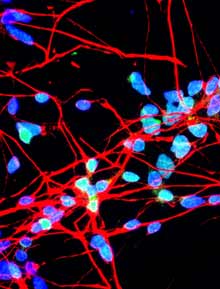Reprogrammed Human Cells Shed Light on Rare Disease
Stem cells generated from patients with a rare neurological disorder are helping scientists dissect the underlying mechanism of the disease and test several candidate drugs. The study, published today in Nature, is the realization of one of the major goals in stem cell research: using induced pluripotent stem (iPS) cells–stem cells derived from reprogrammed adult cells–to study the effects of disease in a patient’s own cells, which are otherwise impossible to access.

The work is “a blueprint for the future of using stem cells to study and treat neurological disease,” says Jeanne Loring, director of the Center for Regenerative Medicine at the Scripps Research Institute. (Loring was not involved in the study.)
The idea is simple: Take skin cells from patients with a particular disease, turn those cells into stem cells, direct those stem cells to become a cell type of interest–for instance, the dopamine-releasing neurons that are affected by Parkinson’s disease–and see how those cells behave and react to different drugs. A spate of recent papers has demonstrated the development of disease-specific stem cells for conditions such as Down syndrome, amyotrophic lateral sclerosis, spinal muscular atrophy, and Parkinson’s disease. The new study is the first to use cells derived from iPS cells to test drugs for their effect against a disease.
Lorenz Studer, lead author of the paper and a developmental biologist at the Sloan-Kettering Institute in New York, and his team focused on a rare disease called familial dysautonomia (FD), which affects neurons that control functions such as the sensation of touch, blood pressure and tear flow. Symptoms usually arise early in life, sometimes from birth, and include a lack of muscle tone and reflex control, problems sensing pain, high blood pressure and difficulty breathing. The disease is caused by a known genetic mutation, but scientists have been unable to create an animal model of the disease.
The researchers obtained skin cells from patients with FD and created lines of iPS cells by inserting four genes into the cells using viruses. This reprogrammed the cells to behave like embryonic stem cells, which can give rise to all cell types. The researchers then directed those undifferentiated cells to turn into specific cell types, including the neural crest cells that give rise to the neurons affected by FD.
FD patients are known to have a mutation in a gene that encodes a protein called IKAP. The mutation causes part of the genetic sequence to be skipped when the gene is translated into a protein; however, the genetic defect only affects certain tissues, for reasons not known. To understand more about the disease, the researchers looked for the normal and mutated protein in the different cell types. Studer says they expected that the neural cells would have more of the abnormal protein. But in fact, they found that the faulty translation happened at equal rates in the different types of cells. Levels of normal IKAP were much lower in the neural cells, which may be why the disease strikes these cells.
The team also found that the cells were defective in their ability to differentiate into neurons and did not migrate as easily as normal cells in a culture dish. The researchers used these differences to measure the effect of three drugs that had been proposed as candidate drugs for FD. One of them, kinetin, a natural plant hormone that is often used as an antiwrinkle treatment in cosmetics, showed promise in treating the cells When cells were treated with the drug, Studer says, “it led to near complete reversal of the splicing defect.” Further treatment reversed the defect in differentiation, although it did not affect the cells’ ability to migrate.
Susan Slaugenhaupt, a neurologist at Massachusetts General Hospital who studies FD, says that these cells help alleviate a long-standing frustration in studying neurological disease. This technology provides “the ability to examine disease-relevant cell types from patients” for the first time, she says. “You can’t get brains from patients and look at these cell types.” Slaugenhaupt is now collaborating with the research team to further test drugs for FD using this model.
Slaugenhaupt adds that this study is the first to show that kinetin can improve disease in neural cells and that it “provides the best evidence to date that long-term treatment with kinetin may be beneficial to FD patients.” Clinical trials of the drug are scheduled to start soon.
Keep Reading
Most Popular
Large language models can do jaw-dropping things. But nobody knows exactly why.
And that's a problem. Figuring it out is one of the biggest scientific puzzles of our time and a crucial step towards controlling more powerful future models.
The problem with plug-in hybrids? Their drivers.
Plug-in hybrids are often sold as a transition to EVs, but new data from Europe shows we’re still underestimating the emissions they produce.
Google DeepMind’s new generative model makes Super Mario–like games from scratch
Genie learns how to control games by watching hours and hours of video. It could help train next-gen robots too.
How scientists traced a mysterious covid case back to six toilets
When wastewater surveillance turns into a hunt for a single infected individual, the ethics get tricky.
Stay connected
Get the latest updates from
MIT Technology Review
Discover special offers, top stories, upcoming events, and more.